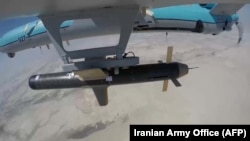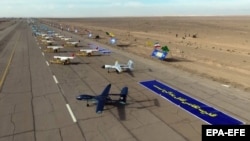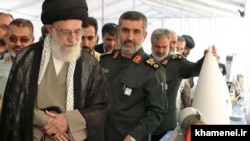Drone Target Feed Drone Targeting Screen
Charred tents, a burned-out motorcycle, and a damaged white SUV vehicle. This was the aftermath of a reported drone strike carried out by the Islamic Revolutionary Guards Corps (IRGC) in southeastern Iran.
The December 28 strike in Rigan county in Kerman Province appears to mark the first time the IRGC, Iran's elite military force, has used drones to target security threats inside the country.
The IRGC said the "precise" operation killed a prominent "bandit" and two of his accomplices who had been fomenting unrest in the area, including killing two IRGC members days earlier.
Rigan county neighbors Sistan-Baluchistan, a volatile province near the border with Pakistan and Afghanistan where drug smugglers, separatists, and militant groups operate. The province's population is mainly ethnic Baluch.
Baluch sources reported that the drone killed at least four Baluch fighters while they were asleep.
The attack has served to highlight Iran's expanding drone capabilities, which Tehran is also increasingly deploying beyond its borders.
Iran has supplied unmanned aerial vehicles (UAVs) to its proxies in the Middle East and employed them during reconnaissance, sabotage, and attack missions in the region, analysts said.
Cheap But Effective
Analysts said that, even though Iran's drone program lacked sophistication, it still posed a significant threat in the region, where there has been a surge in drone attacks carried out by nonstate actors with ties to Tehran.
"Think of it as the Toyota Corolla of drones," said Aaron Stein, the research director at the Foreign Policy Research Institute, a U.S.-based think tank, referring to the dependable Japanese-made passenger car.
"They are ubiquitous and good enough to get you there, but not fancy and flashy," Stein told RFE/RL, adding that many Iranian drones are believed to be pieced together from commercial parts.
He added that Iranian drones pose a threat to U.S. forces stationed in the region, including in neighboring Iraq, where American military installations have been targeted by pro-Iranian militias.
"Iran's proliferation of UAVs across the region threatens international peace and stability," Deputy U.S. Secretary of the Treasury Wally Adeyemo said in October while announcing sanctions against two IRGC officials, two other individuals, and two companies, which Washington said provide critical support to the IRGC's drone program.
"Iran and its proxy militants have used UAVs to attack U.S. forces, our partners, and international shipping," Adeyemo added.
Jeremy Binnie, a defense analyst at Janes, a Britain-based open-source intelligence company, said Iranian drones have made pro-Iranian armed groups in Iraq, Syria, and Yemen unpredictable.
"The long-range UAVs can be programmed with nondirect flightpaths so they can attack targets from unexpected directions," Binnie told RFE/RL.
"Such weapons have proven difficult to stop, partly because air defense radar systems were typically developed to detect far faster threats with larger radar and/or heat signatures and also because the air defense systems designed to intercept such low-flying threats only have a short-range," he added.
Binnie said the "relatively unsophisticated" drones have allowed pro-Iranian proxies to "carry out low-level attacks that maintain pressure on their adversaries, as we see regularly in Iraq and Yemen," where they have been used by Huthi rebels.
Difficult To Stop
Analysts said drones have also allowed Tehran to maintain plausible deniability even as it carries out covert operations in the region.
In 2019, a drone attack on Saudi Arabia's oil facilities halted more than half of the nation's daily output. The Iran-aligned Huthis claimed responsibility for the attack, while U.S. officials blamed Iran.
In November 2020, a drone exploded near the front door of the Baghdad residence of Iraqi Prime Minister Mustafa al-Kadhimi, injuring his bodyguards. Some officials blamed the attack on Iran-backed militias, although some reports suggested that Tehran had not ordered the strike.
In recent months, reports have emerged of Iranian-made Mohajer-6 drones being spotted in Ethiopia amid a raging civil war in the East African nation.
In August, the United States, Britain, and Israel accused Iran of carrying out a drone attack on an oil tanker in the Arabian Sea that killed two people on board.
In September, the IRGC said it had used drones to target Kurdish armed groups based in Iraq's northern Kurdistan region.
On January 17, the Huthis claimed responsibility for an attack targeting a key oil facility in the United Arab Emirates, saying it used missiles and drones. The attack killed three people and caused a fire near the airport of the capital, Abu Dhabi. Iran has been widely accused of supplying arms to the Huthis.
"As for who's responsible for it, I think that we should take the Huthis at their word," tweeted Dave Des Roches, a senior fellow at the Washington-based Gulf International Forum (IGF) and an associate professor at the Near East South Asia Center for Security Studies. "The only question is how much of it is Huthi/Huthis, how much of it is Iran/Huthis."
Binnie said Iran, reeling from years of crippling U.S. sanctions over its nuclear program, had developed drones as "a low-cost way" to compensate for its lack of a modern air force.
"The Iranian military, especially the IRGC, has invested heavily in developing a wide range of UAVs," he said.
They include "long-endurance surveillance and attack platforms like the Shahed-129," so-called "suicide" drones that are effectively slow cruise missiles, and stealth drones "for penetrating well-defended airspace," said Binnie.
Boosting Its Arsenal
Tehran's drone program dates back to the devastating 1980-88 Iran-Iraq War, when Iranian forces started to use drones for reconnaissance purposes.
In 2012, Iran claimed it had reverse engineered an advanced U.S. drone it had captured the year before. State media claimed that the move led to the development of a newer range of combat drones.
IRGC aerospace commander Amir Ali Hajizadeh said last year that the decision to boost the country's arsenal of drones came after a meeting held "three or four years ago" with Supreme Leader Ayatollah Ali Khamenei.
Hajizadeh said Khamenei praised the drone program while stating that the country's stockpile was too low.
"After that we all mobilized to increase the number of UAVs," Hajizadeh was quoted as saying by the hard-line Fars news agency.
In recent years, Iran has become a prolific drone producer and showcases its surveillance, attack, and weaponized drones during military parades.
Source: https://www.rferl.org/a/iran-drone-program-threats-interests/31660048.html





0 Response to "Drone Target Feed Drone Targeting Screen"
Post a Comment